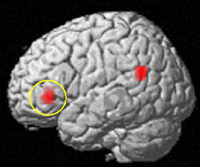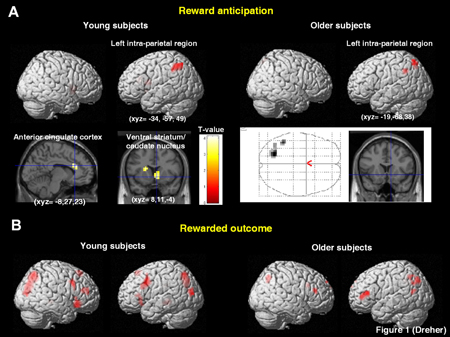Archived Content
The National Institute of Mental Health archives materials that are over 4 years old and no longer being updated. The content on this page is provided for historical reference purposes only and may not reflect current knowledge or information.
Why “My Get Up and Go Has Got Up and Went”
Brain’s Reward Circuit Activity Mostly Ebbs as We Age
• Science Update

Is reward circuitry
“retuned” in old age?
If, as the song laments, our "get up and go" fades as we get older, it may stem from aging-related changes in a brain reward circuit. Compared to young participants, older participants showed less activity in brain motivation hubs while they viewed a slot machine-like video game and received money in a NIMH brain imaging study.
Using two different types of brain scanners in the same participants, the researchers demonstrated for the first time in living humans how the activity of dopamine, a key messenger chemical, in the middle of the brain affects reward related circuitry at the front of the brain — and how this changes as we age.
Karen Berman, M.D., Jean-Claude Dreher, Ph.D., and colleagues in the NIMH Section on Integrative Neuroimaging report on their findings online September 15, 2008, in the Proceedings of the National Academy of Sciences.
"Knowing how key brain circuits change as we get older may help us rise to the public health challenge of aging successfully as longevity increases," said Berman. "In addition to enhancing our understanding of changes we experience in normal aging, this line of research may someday shed new light on disorders of the dopamine system and reward processing, such as schizophrenia, pathological gambling, drug addiction and Parkinson's disease."
How dopamine activity in the human midbrain affects reward-related circuit activity in frontal areas was not known. Nor was it known how this circuit changes as humans age — the dopamine system being particularly vulnerable.
To find out, Berman, Dreher and colleagues first scanned 13 aging participants in their 60s and 20 young participants in their 20s while they viewed a slot machine-like game on a computer screen — detecting their moment-to-moment brain activity via functional magnetic resonance imaging (fMRI).
While they were anticipating winning money, three parts of a reward center all activated in the young participants: the striatum, an attention hub called the cingulate, and another attentional area on the left side of the brain called the parietal area. By contrast, only the parietal area activated in older participants. Since dopamine is known to play a major role in this circuit, particularly in the striatum, this finding may reflect a waning dopamine system in the elderly participants, suggested Berman.
At the time the monetary reward was actually delivered, a large stretch of frontal and parietal cortex activated in young participants, but less robustly in older participants. This may indicate that older peoples' brains are simply less sensitive to important rewards, say the researchers.
The researchers next used a positron emission tomography (PET) scanner to measure dopamine synthesis in a subset of the same subjects and related these levels to the brain activations imaged using fMRI. Dopamine increases deep in the midbrain were linked to increased prefrontal cortex activity in the young participants, but to decreased activity in the older participants, both during reward anticipation and delivery. This opposite effect could be a compensatory response to reduced prefrontal dopamine stimulation in the elderly, propose the researchers. Previous studies in animals have suggested that such a dopamine tuning mechanism operates to optimize information processing by the prefrontal cortex.
"The relationship between the midbrain and the frontal cortex appears to have been retuned in old age," said Berman. "Targeting these dopamine mechanisms may hold promise for developing new ways to treat disorders of the reward system."

Both during anticipation and delivery of rewards, older participants showed mostly lower levels and fewer areas of activation (red) than young participants. fMRI data superimposed on structural MRI 3D brain surface renderings.
Source: NIMH Section on Integrative Neuroimaging

Both during anticipation and delivery of rewards, frontal brain areas (red areas circled in yellow) that increased in activity with increasing midbrain dopamine in younger participants decreased in older participants. These areas showed this opposite response in the older participants, perhaps as a way of compensating for a toned-down dopamine system, suggest the researchers. fMRI data superimposed on structural MRI 3D brain surface renderings.
Source: NIMH Section on Integrative Neuroimaging
Reference
Dreher JC, Meyer-Lindenberg A, Kohn P, Berman KF. Age related changes in midbrain dopaminergic regulation of the human reward system. Proc Natl Acad Sci USA. 2008 Sept 15 [Epub ahead of print].
